Why Media Literacy? A Catholic Reflection
|
Introduction to Forming Values in the Media Age, A Sourcebook for Media Literacy Education in Catholic Schools and Parishes, |
We live in the information age. It's said often, but what does it mean? Let's examine it. The amount of information in the world doubles every five years.1 Imagine, every five years the world's information doubles!
But there's more to the information explosion than that. Consider this: there is more information in the daily edition of The New York Times than an individual man or woman in the 16th Century had to process in their whole lives. More information in a daily newspaper than in a lifetime!
And that doesn't include all the information we have to process from other sources: television, film, computers, phone, fax, magazines and billboards. Explosion is an understatement. At the same time, one-fifth of the adult population in the U.S. is functionally illiterate.2
Just because there is more information doesn't mean there is more knowledge. In fact, the information age leaves many of us numb. We are incapacitated by the sheer volume of material we need to keep abreast of and often lack the skills to "read" the images. We can't see the knowledge for the information. The "mediated" world we live in, and the one our children are growing in, poses significant challenges. As Catholic religious educators, ministers and teachers we need to rise to this challenge in creative ways. We need to process the publications, translate the television, make sense of the music videos. We need a decoder for the data. Media literacy is that decoder.
Media literacy provides the tools not just for critical awareness, but for critical autonomy.
The National Catechetical Directory illustrates the call for media literacy this way: All who use the communications media in their work have a duty in conscience to make themselves competent in the art of social communication, and this applies in particular to people with educational responsibilities, including catechists. Catechists should learn how to take media into account as a crucial part of the cultural background and experience of those being catechized; how to use media in catechesis; and how to help their students understand and evaluate media in light of religious values.3
Over the last decade, countries like Canada, Scotland, England and Australia have developed and refined constructive ways to teach media literacy. Some, like the Ontario Ministry of Education, have made media literacy a mandatory part of the English curriculum for grades seven through 12. It becomes evident that as we move toward an increasingly electronic and image-based culture, we must provide tools to help people understand the media, its messages and its effects.
Goal: Values Education
The concept of media literacy is not a means to innoculate against the influence of culture, but a way to assist in the development of "critical awareness." It strives to move the recipient from passive consumption of media to discriminating interaction with media, empowering people to resist destructive elements and celebrate positive ones.
In the past, there has been a tendency to "blame" the media, an "us against them" approach. Education about the media often focused only on questions of whether material was "good" or "bad." In the '80s, media educators shifted their approach, widening the lens, to examine the broader context of the media: their political, social, and economic impact.
What, for example, are the political implications of reporters going to a morning press briefing in the White House to find out what went on in the world in the last 24 hours? What are the economic implications of the shift in the focus of tobacco advertising from men to women in the early '80s, and to youth and the developing world in the '90s? What are the social implications of gender roles as portrayed through soap operas or rock videos? Media literacy stresses our responsibility to participate in the process of studying those questions.
The principles of media literacy act as a coherent umbrella for examining diverse mediums and divergent issues presented in this information age. The principles of media literacy, combined with the reflection model provided by the Pastoral Circle, which we use in the sample sessions, form a potent foundation for consciousness-raising. Media literacy provides the tools then, not just for critical awareness, but for critical autonomy.
Media literacy isn't something you "learn" in one sitting, it's a consciousness that develops over time. We hope to provide some examples to get you started, and to spur your creativity to adapt and augment this material.
We need to process the publications, translate the television, make sense of the music videos. We need a decoder for the data. Media literacy is that decoder.
*****
Footnotes:
1. Bill Moyers, World of Ideas, interview with Vartan Gregorian, (Doubleday, 1989), p. 182.
2. Jonathan Kozol, Illiterate America, (NAL/Dutton, 1986), puts the figure as high as one third.
3. National Catechetical Directory of the United States, Sharing the Light of Faith, (United States Catholic
Conference, 1979), p. 157, No. 261.
4.The document Aetatis Novae, Pastoral Instruction in Social Communication, was released by the Pontifical Council for Social Communication on the 20th anniversary of Communio et Progressio,March 17 1992. (For the complete text of the document see Origins, NC Documentary Service, March 26, 1992), Vol. 21, No. 42.



